
The Japanese Larder
Bringing Japanese Ingredients into Your Everyday Cooking
by Luiz Hara
This title was previously available on NetGalley and is now archived.
Send NetGalley books directly to your Kindle or Kindle app
1
To read on a Kindle or Kindle app, please add kindle@netgalley.com as an approved email address to receive files in your Amazon account. Click here for step-by-step instructions.
2
Also find your Kindle email address within your Amazon account, and enter it here.
Pub Date Oct 16 2018 | Archive Date Dec 19 2018
Quarto Publishing Group - Jacqui Small | Jacqui Small
Talking about this book? Use #JapaneseLarder #NetGalley. More hashtag tips!
Description
Most of us have heard of ingredients such as miso, mirin, tofu and matcha, but how many of us feel confident using these ingredients in our everyday cooking? In this beautifully illustrated cookbook, Luiz Hara introduces the ingredients in authentic Japanese recipes and shows you how they can transform all types of non-Japanese dish. With over 100 delicious and easy-to-make everyday recipes, you can discover how to use leftover miso, noodles or soy sauce to elevate any dish into a mouth-watering meal.
From the author of Nikkei Cuisine, The Japanese Larder is an inspirational cookbook that celebrates the diversity and versatility of Japanese ingredients – from tofu and persimmon to green teas and dashi broth. Grab that packet of miso paste from your fridge, buy some ponzu or yuzu from the ethnic section of your local supermarket, and discover a new world of taste and flavour thanks to Luiz’s delicious recipes.
Marketing Plan
Key Campaign Activity • Long lead media outreach • Gift guides for Dec. 2018 Pre-publication: • Long lead national media outreach to food and lifestyle media • Author promotion of The London Foodie Trade: • Submit for review in Publishers Weekly, Shelf Awareness, Booklist and Foreword Reviews • Display at BEA/BookCon School/Library : • Submit for review in Library Journal • Display at ALA Annual and Midwinter Conferences Consumer: • Goodreads giveaway • Promotion on Quarto Cooks • Submit for James Beard and IACP Cookbook Awards Publicity/Media: • Magazine: Food & Wine, Martha Stewart Living, Vogue, bon appetit, Gather Journal, Saveur, Edible, Sweet Paul, Real Simple, People, Rachael Ray Every Day, Good Housekeeping, Parade, Women’s World, Cherry Bombe, O The Oprah Magazine, Cooking Light, Martha Stewart Living, Fine Cooking, Newsweek, The Week, Food Network Magazine, Family Circle • Newspaper: The New York Times, Wall Street Journal, Washington Post, The Boston Globe, Los Angeles Times, Philadelphia Inquirer, AM New York, Austin American Statesman, Pittsburgh Post Gazette, Chicago Tribune, food editors from top 25 regional newspapers • Online: Epicurious, bon appetit Healthyish, Eater, Buzzfeed, Food52, Huffington Post, Eat Your Books, Tastebook, Cooking with Amy, Delish, The Kitchn, Design Sponge, Food Republic, Radio: NPR The Salt, NPR The Splendid Table, The Level Teaspoon, WNYC Leonard Lopate
Available Editions
| EDITION | Other Format |
| ISBN | 9781911127628 |
| PRICE | $35.00 (USD) |
| PAGES | 256 |
Average rating from 45 members
Featured Reviews
An absolutely amazing book on Japanese Cooking. So much information on the ingredients and the recipes are so easy to read. The pictures are so beautiful I would like to cook everything in this book. Although I only got it today, I have looked at every page, unfortunately I can’t cook anything yet as I am on holidays. My friends were so impressed with the book and the recipes that I have already ordered a copy for them. I can’t wait till my Japanese daughter in law comes over so I can impress her with a dish from this book.
Thanks to Netgalley and Quarto Publishing Group - Jacqui Small fit the opportunity to read and review.
 Educator 251522
Educator 251522
Very easy to follow recipes and there is a picture of everything! Can't wait to start cooking these delicious looking meals!
 Critter B, Librarian
Critter B, Librarian
Great collection of recipes, ingredient info and 'how to make' guides! I love most Japanese flavours, and look forward to making udon and tofu from scratch. Note - the ingredients involve a lot of traditionally Japanese ingredients, but there surely are some new touches added to those traditional ingredients.
 Catherine C, Reviewer
Catherine C, Reviewer
This book Japanese Larder is nothing like an usual cook book about Japan. It gives you great insights about how to include usual japanese cooking elements into our occidental cooking.
 Abby S, Reviewer
Abby S, Reviewer
Loved this gorgeous cookbook. A wonderful guide to Japanese cooking teaches us what we need in our pantries what spices rice etc.The recipes are easy to follow the pictures are beautiful mouth watering .This is perfect for anyone interested in Japanese cooking and would make a lovely gift.
#netgalley #JapeneseLarder#Quartopublishers,
 Librarian 391714
Librarian 391714
I really love this! I am passionate about bringing Japanese cuisine and culture into my household and I feel like the recipes of Hara's make this feat possible.
This is a very handy book for anyone interested in Japanese cooking! Each chapter focuses on a type of food - seasonings, dried/fermented foods, rice/noodles/tofu, fruits/vegetables, etc. The photos that accompany the recipes are beautifully shot. Recipe ingredients are listed by weight and volume in most cases - a nice inclusion for better accuracy. While many of the recipes aren't ones I particularly will be trying since I don't consume animal products, I still found quite a number of recipes I will be trying out and hopefully adding to my favorites. Aside from the recipes, this book would make a perfect reference for cooks looking to branch out and use ingredients they may be less familiar with.
Thank you to Quarto Publishing Group - Jacqui Small and NetGalley for the opportunity to read this informative book in exchange for my honest review.
 Dayna K, Reviewer
Dayna K, Reviewer
The book is very pretty. I wish it would send to kindle but I suppose I should have looked closer. I love Japanese food and this book makes the fofoofofood not seem so scary to make
 Janet P, Reviewer
Janet P, Reviewer
A gorgeous cookbook that is full of great information & interesting recipes. Hara's theme is understanding Japanese ingredients and using them in a wider variety of recipes, both Japanese & Western. Therefore his chapters are organized by type of ingredient rather than by course.
Each chapter opens with a section on these ingredients, how they are made, flavored, and used. The recipes follow, each with the dish pictured.
While some of the recipes are quite complex, many use off-the-shelf ingredients, making them easily accessible to home cooks.
Although Hara is UK-based he has done a good job of making a cookbook easy to use by cooks in the UK and North America.
I can't wait to try the recipes in this book! I love the way that it's set up and I love the pictures that accompany the recipes!
I honestly can't remember the last time I came across such a complete guide to Japanese cookery. Every dish has an accompanying picture which is beautifully shot. Not only are the much needed seasonings for the dishes listed, they come with brief a overview, which make for a rather informative and interesting read. The recipes are step by step, but detailed so there's far less chance of making a mistake.
Can't say enough nice things about this book. Highly recommended.
This book was received as an ARC from Quarto Publishing Group - Jacqui Small in exchange for an honest review. Opinions and thoughts expressed in this review are completely my own.
I was immediately drawn into this book by the artistic talent of the cover. I was always intrigued by Japanese Cooking not just for the looks but for the taste. I always feel better/energized after you eat Japanese cooking. A lot of the recipes were very easy to follow followed by beautiful pictures of each completed dish. Anyone that makes any of these recipes will feel like the next Morimoto. I especially loved the Buta No Kakuni and the Miso Brown Butter Linguini and I can't wait to make them and wow my guests. This might even be a potential candidate for our cooking demo program at our library.
This will definitely have a home in our Non-Fiction cookbook section at our library. That is why we give this book 5 stars.
I really enjoyed this book. I love t learn about Japanese cuisine. What is special about this book is that it goes into what the ingredients are and why they are used. In other books, they just mention these foreign spices, sauces, fruits, and vegetables like Westerners would understand. Luiz Hara helps you understand these products and you start to conceptualize why they are used and what the dishes may actually taste like.
I loved teh photos of teh dishes as well as the ones that chronicle the shops and supplies.
I would recommend Japanese Larder to anyone interested in learning about Japanese cooking.
 Leyla J, Reviewer
Leyla J, Reviewer
Over the years we have become very versed in Asian cooking with the easy availability of ingredients, many cookbooks, and restaurants throughout our world. That is, all but Japanese cooking, it is true that there are some restaurants opened in recent years but the ingredients are a bit of a mystery to most of us.
This book remedies that, it gives a very full explanation of ingredients and uses in recipes, with that comes glorious photographs of the food, presented as only the Japanese can, like a piece of art.
Having said that, this is not a Japanese cookbook but more a familiarisation and explanation of the ingredients and uses in Japanese cooking. It does include some recipes, maybe more familiar to the English taste but adapted with the use of Japanese ingredients.
An extremely interesting book, very informative well presented with a touch of encouragement and confidence to try using some of the ingredients in everyday home cooking.
 Justine B, Librarian
Justine B, Librarian
My first time through this book I just looked at all of the gorgeous pictures. The food looked scrumptious and the people and places looked inviting. When I went back in to read the information and the recipes, I fell even more in love with this book. As a home cook I appreciate ingredients that are new to my pantry. This book gave me plenty to work with and also the knowledge I need to use them without a recipe.
 Ashley R, Reviewer
Ashley R, Reviewer
I received a free copy for an honest review through Netgalley. That being said, I collect cookbooks and recipes like crazy. I have Japanese cookbooks already, and this still taught me knew tricks and skills. The recipes are clear and concise, and explain substitutions and ways to incorporate Japanese techniques and flavors with the non traditional to create new and flavorful ideas. I’ve been making tsukemono, onigiri, and oden for years, so seeing other recipes and twists are always wonderful, especially learning more about the processes of items. I really liked the step by step process of tofu making, as that was on my to learn list! I love making desserts and sweets, so I was happy to see a few recipes, but would have liked a few more. Mochi and red bean paste are easy to use and modify, but sadly were not in here.
There are so many Asian cookbooks out there, but I have found few that concentrate on just the Japanese region. Even fewer that are so well written as this one! And also beautifully photographed.
Hara really does a great job of introducing the reader to Japanese cuisine. He covers everything that I could ever think of. There are chapters on key seasonings, various ingredients, spices, teas, sauces, marinades, and on and on. The author describes the different kinds of fruits and vegetables used in Japanese cooking. And a great chapter on just rice and noodles.
Throughout all the chapters, he introduces the reader to easy to understand recipes. As well as where and how some of the ingredients are produced.
Hara makes the entire book easy to read, and inviting. Now that I understand what some of the items are, I can't wait to go to the Asian grocery store to find some of them to try!
I received a copy of this book from NetGalley, in exchange for a fair review. I can honestly say that I will be purchasing additional copies for my friends who love to cook!
Well laid-out recipes with magnificent pictures brought this amazing treasure-trove to life. Kicking things off, the traditional seasonings to provide for authentic Japanese Cuisine were listed. Easy to follow, clear explanations were provided for each and every recipe. A photographic work of art, many of the dishes were shown beautifully plated. They almost looked too good to eat. Not really. This is a must-have book for anyone wanting to learn how to prepare delicious Japanese meals.
I extend my gratitude to NetGalley and Quarto Publishing Group - Jacqui Small for this ARC in exchange for an unbiased review.
 Reviewer 311821
Reviewer 311821
If you're looking for a cookbook focused on traditional Japanese recipes/cuisine, then keep looking. Instead, this book takes a focus on essential ingredients that are traditionally found in Japanese cuisine. Nearly everyone is familiar with some, while others might be hard to find outside Japan. Hara takes those ingredients an shows how they can be used in all sorts of dishes. Sure there are some traditional recipes (dashi stock comes to mind), but there are a whole lot that are inspired from different sorts of cuisines and dishes.
The amount of information in the book can be almost overwhelming. It acts as a primer on a lot of different ingredients and how they play a role in Japanese food. Someone starting out could be intimidated by that. To that I say take it one section at a time. The first chapter focuses on the quintessential ingredients. These are the ones that are most common and you've at least heard about before. Each subsequent section takes a different grouping of ingredients and the recipes build by incorporating these staples from one or more sections.
One thing that is great for less experienced cooks is that there are a ton of photos. I'm not sure if there is a picture for every recipe, but it certainly comes close. The food looks great too. With food it is always nice to have some sort of visual guide of how you should expect it to come out. I think this book does a great job of making these ingredients accessible.
I loved reading this book and using it to add to my home cooking. I have been a fan of adding Japanese ingredients to my food for a long time; miso paste and seaweed are common ingredients that I add to my vegetable stock. I used this book to add to my cooking and really try to understand what it was that made Japanese food so special and interesting to me. There is a unique mixture of flavors and umami that is prevalent in Japenese food that I love and this book helped me see that more. Other than learning about adding these Japanese elements into my cooking, the photography was amazing! It alone would have warranted an amazing book about Japanese cooking elements.
This book is giving my boring cooking tendencies new life! I was thrilled to receive a copy of this from NetGalley, thank you. This is a beautiful publication -- an inspiring collection of recipes that aren't scary to tackle on a weekday, even! I appreciate all the work and knowledge you put into it, Luiz Hara.
4.5 stars!
 Book Trade Professional 2393
Book Trade Professional 2393
I've always enjoyed Japanese food - excluding seafood, I find the flavors and the style to be to my liking. That said I've had trouble finding an authentic cookbook that gives me the very basics in a way that I can replicate in a style that I like.
The JAPANESE LARDER definitely offers something for someone looking to understand the basics and some fancy prep for the dishes. Hara breaks down the why, the how, and the interesting before jumping into anything complicated. Sometimes knowing WHY there are multiple different ways to pickle a vegetable helped me understand which to use in my recipes.
The recipes do take some time, especially if you're not one who has patience (like me) when prepping. It is important to pay attention to his measurements and to how he says to prepare the basics like dashi or the ponzu sauces.
I've also found new dishes I want to try before I attempt to make (like Nikujaga - Japanese style beef & potato hotpot) and I'm glad that he gave a good overview for Tempura at home! I love Tempura so that section in particular has been helpful.
 Reviewer 311015
Reviewer 311015
What a lovely recipe book. With loads of info about an incredibly interesting culture it's full of mouth watering recipes that really wants me to rush out and make things. A good balance is kept between using traditional ingredients and readily available items you can find in any supermarket. And while some recipes doesn't feel very Japanese they all look delicious and the whole book is firstly a great recipe book, but also a nice journey into a delicious cuisine.
 Shaleah K, Reviewer
Shaleah K, Reviewer
I received a free ARC from Netgalley.
This is a great cookbook for those that have no idea how to cook Japanese or even what makes Japanese food. Ingredients are explained and pictures given. Recipes are thorough (even told me how to clean a garlic clove!).
For those that want quick Japanese food, this is not for you. There are specific ingredients needed that aren't available at American markets.
The recipes are in metric with conversions in parentheses. This can throw an American cook off at first. Some pictures were confusing--the words and signs are in Japanese--and I didn't know what I was looking at. Others were people pictures that weren't significant to me.
I found recipes that I want to try but will need to make a list for Asian ingredients first.
The Japanese Larder is a fantastic cookery book for anyone wanting to make Japanese cuisine. It is full of delicious looking recipes and photography.
It is split into 7 chapters plus an Introduction. The book covers many aspects of Japanese food including Key Seasonings, Dried, fermented & preserved ingredients, Spices, condiments & garnishes, Rice, noodles & tofu, Fruit & vegetables, Tea & other beverages and Sauces, marinades & garnishes.
There is so much to pick from in this book and to learn. I love the way it includes photography of the raw ingredients such as a bitter melon, the condiments and much more. So so helpful for shopping!
Each recipe is explained very well and comes with a colour photograph so you know what it should look like - too many other books lack this kind of detail but this one gets it right as with a new recipe you need to know what you are going to eat. It explains how to make lumpy tempura - yes it should be lumpy - and also covers how to make your own tofu.
Measurements are in both imperial and metric and as mentioned there is loads of photography of the complete recipes, ingredients plus food in Japan.
I would certainly like to add this book to my cookery book collection and would cook the slow-braised pork belly as my first dish and I'm sure it wouldn't be the last one I tried. There is plenty to pick and it's not all fish and sushi!
I received this book from netgalley in return for a honest review.
 Lesley K, Reviewer
Lesley K, Reviewer
This went so far beyond the realm of a typical cookbook! It was obviously painstakingly researched and compiled, and the attention to detail made it a pleasure to peruse. The photographs are absolutely stunning, food as works of art. The recipes are complex in their own right, but simple enough for most home cooks. I loved the sections devoted to cocktails and sauces, they gave me ideas I have never considered before.
 Karen H, Reviewer
Karen H, Reviewer
The Japanese Larder by Luiz Hara is the best cookbook out there to demystify Japanese ingredients. It’s well-written, and has excellent information for those who want to cook authentic Japanese. Hara knows his subject well, and does an excellent job of explaining. This is a “must have” book to read before visiting the Japanese grocery store, and in most homes will have a special place on the cookbook shelf to reference questions on Japanese cooking. Highly recommended.
Wow! What a fabulous book! There is so much information about the ingredients, with explanations of different varieties of each ingredient, the ways they are used, how they are made, regional differences, etc. The recipes are easy to follow and understand, and the photographs are gorgeous! I want to eat everything! A great gift for the foodie and/or otaku in your life!
Readers who liked this book also liked:
Jennifer Love Hewitt
Biographies & Memoirs, Nonfiction (Adult), Parenting, Families, Relationships
Kim Hana; Hwang Sunwoo
Biographies & Memoirs, Nonfiction (Adult), Parenting, Families, Relationships
Annabelle Gurwitch
Biographies & Memoirs, Health, Mind & Body, Humor & Satire


















